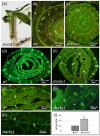Stocky1, a Novel Gene Involved in Maize Seedling Development and Cuticle Integrity
- PMID: 35406827
- PMCID: PMC9003528
- DOI: 10.3390/plants11070847
Stocky1, a Novel Gene Involved in Maize Seedling Development and Cuticle Integrity
Abstract
The cuticle is the plant's outermost layer that covers the surfaces of aerial parts. This structure is composed of a variety of aliphatic molecules and is well-known for its protective role against biotic and abiotic stresses in plants. Mutants with a permeable cuticle show developmental defects such as organ fusions and altered seed germination and viability. In this study, we identified a novel maize mutant, stocky1, with unique features: lethal at the seedling stage, and showing a severely dwarfed phenotype, due to a defective cuticle. For the first time, the mutant was tentatively mapped to chromosome 5, bin 5.04. The mutant phenotype investigated in this work has the potential to contribute to the elucidation of the role of the cuticle during plant development. The possibility of controlling this trait is of relevance in the context of climate change, as it may contribute to tolerance to abiotic stresses.
Keywords: maize cuticle; plant cuticle; seedling development.
Conflict of interest statement
The authors declare no conflict of interest.
Figures




References
-
- Rousseau D., Widiez T., Di Tommaso S., Rositi H., Adrien J., Maire E., Langer M., Olivier C., Peyrin F., Rogowsky P. Fast Virtual Histology Using X-Ray in-Line Phase Tomography: Application to the 3D Anatomy of Maize Developing Seeds. Plant Methods. 2015;11:55. doi: 10.1186/s13007-015-0098-y. - DOI - PMC - PubMed
-
- Harada J.J. Seed Maturation and Control of Germination. In: Larkins B.A., Vasil I.K., editors. Cellular and Molecular Biology of Plant Seed Development. Springer; Dordrecht, The Netherlands: 1997. pp. 545–592. Advances in Cellular and Molecular Biology of Plants.
-
- Widiez T., Ingram G., Gutiérrez-Marcos J.F. Maize Kernel Development. Cabi; Wallingford, UK: 2017. Embryo-Endosperm-Sporophyte Interactions in Maize Seeds.

